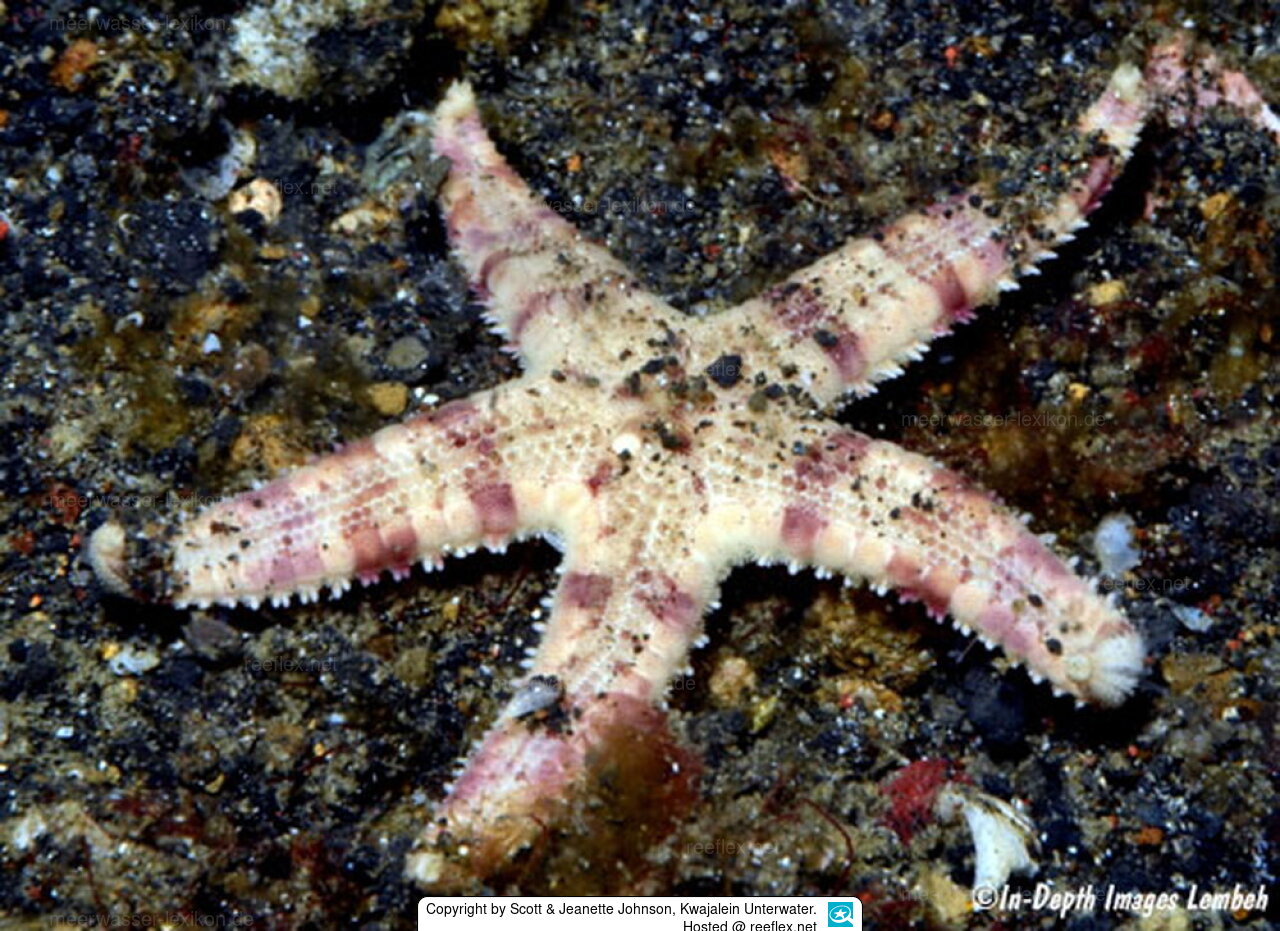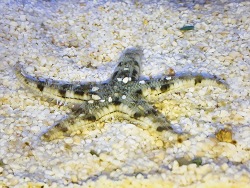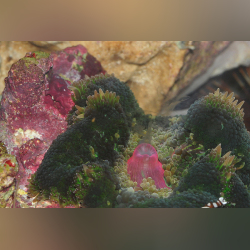Info
Archaster typicus Müller & Troschel, 1840
The type locality for the description of Archaster typicus is Sulawesi.
Archaster typicus is a five-armed starfish with long, slightly tapering arms with pointed ends. Occasionally, three-, four- or even six-armed specimens are also found. Adult animals grow to 12 to 15 centimeters in diameter, with males often being smaller than females.
This starfish is adapted to life on the sandy seafloor, where it buries itself in the sediment at high tide and crawls over the sediment surface at low tide.
The general color is gray or brownish, with a varied pattern of darker and lighter spots that sometimes form an angular pattern. The underside is pale. The body is slightly bloated and there is a whitish madreporite near the center of the disc. The small armor plates covering the upper side of the arms are arranged in neat parallel rows, which distinguishes it from the rather similar Astropecten polyacanthus, which has similar growth forms and coloration. The marginal spines are short, flat and blunter than those of Astropecten polyacanthus, and the tube feet have suction cups and no spines.
Like other sea stars, Archaster typicus spawns freely, i.e. male and female sea stars release their gametes into the sea, where fertilization takes place. The larvae settle between mangroves, while individual animals gradually move into seagrass and sandy habitats with age.
In contrast to most other sea stars, however, Archaster typicus performs a pseudocopulation. The specimens reach sexual maturity at a radius of 29 mm. About two months before spawning, the starfish begin to gather, with the males in particular becoming more mobile. A starfish can recognize whether another is male or female, probably by chemotactic recognition. When the male recognizes a female, it climbs on top of her and can remain there for two months. The female can move and feed, but the male is more restricted in his activities. During this time, they synchronize their gonadal activity so that the male is ready to spawn when the female is ready to spawn. When she releases her eggs, he releases his sperm almost simultaneously, increasing the chances of successful fertilization.
Mating occurs in the Philippines in September and October, and the pair density reaches up to 7 pairs per square meter at full moon, while none can be found at new moon.
The digging starfish is an excellent scavenger that lives on the remains it finds in the soil (detritus).
Synonymised names
Astropecten (Astropus) Gray, 1840 · unaccepted (Synonym)
Astropecten (Astropus) longipes Gray, 1840 · unaccepted
Astropus longipes (Gray, 1840) · unaccepted
The type locality for the description of Archaster typicus is Sulawesi.
Archaster typicus is a five-armed starfish with long, slightly tapering arms with pointed ends. Occasionally, three-, four- or even six-armed specimens are also found. Adult animals grow to 12 to 15 centimeters in diameter, with males often being smaller than females.
This starfish is adapted to life on the sandy seafloor, where it buries itself in the sediment at high tide and crawls over the sediment surface at low tide.
The general color is gray or brownish, with a varied pattern of darker and lighter spots that sometimes form an angular pattern. The underside is pale. The body is slightly bloated and there is a whitish madreporite near the center of the disc. The small armor plates covering the upper side of the arms are arranged in neat parallel rows, which distinguishes it from the rather similar Astropecten polyacanthus, which has similar growth forms and coloration. The marginal spines are short, flat and blunter than those of Astropecten polyacanthus, and the tube feet have suction cups and no spines.
Like other sea stars, Archaster typicus spawns freely, i.e. male and female sea stars release their gametes into the sea, where fertilization takes place. The larvae settle between mangroves, while individual animals gradually move into seagrass and sandy habitats with age.
In contrast to most other sea stars, however, Archaster typicus performs a pseudocopulation. The specimens reach sexual maturity at a radius of 29 mm. About two months before spawning, the starfish begin to gather, with the males in particular becoming more mobile. A starfish can recognize whether another is male or female, probably by chemotactic recognition. When the male recognizes a female, it climbs on top of her and can remain there for two months. The female can move and feed, but the male is more restricted in his activities. During this time, they synchronize their gonadal activity so that the male is ready to spawn when the female is ready to spawn. When she releases her eggs, he releases his sperm almost simultaneously, increasing the chances of successful fertilization.
Mating occurs in the Philippines in September and October, and the pair density reaches up to 7 pairs per square meter at full moon, while none can be found at new moon.
The digging starfish is an excellent scavenger that lives on the remains it finds in the soil (detritus).
Synonymised names
Astropecten (Astropus) Gray, 1840 · unaccepted (Synonym)
Astropecten (Astropus) longipes Gray, 1840 · unaccepted
Astropus longipes (Gray, 1840) · unaccepted







 Scott & Jeanette Johnson, Kwajalein Unterwater
Scott & Jeanette Johnson, Kwajalein Unterwater








